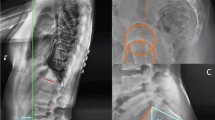Abstract
Introduction
Obesity is an increasing problem of epidemic proportion, and it is associated with various musculoskeletal disorders, including impairment of the spine. However, the relationship between obesity and spino-pelvic parameters remains to date unsupported by an objective measurement of the mechanical behavior of the spino-pelvic parameters depending on body mass index (BMI) and the presence of central obesity. Such analysis may provide a deeper understanding of this relationship.
Purpose
To assess whether BMI and central obesity are associated with modifications on spino-pelvic parameters and determine if exists any correlation between BMI and obesity with the type of lumbar lordosis (LL).
Methods
A cross-sectional study with 200 participants was conducted. Parameters measured were LL, pelvic tilt, sacral slope, and pelvic incidence (PI), using lumbosacral radiographs in lateral view. Subjects were classified depending on BMI. In a secondary analysis, the subjects were categorized into two groups depending on the presence or not of elevated abdominal circumference. The categorical variables were compared using Chi-square test, and the mean values were compared using ANOVA and student t test. A Spearman correlation test was used to analyze the correlation between BMI categories and LL types.
Results
From the total of participants, there were 51 (25.5 %) normal weight subjects, 93 (46.5 %) overweight, and 56 (28 %) obese individuals. The spino-pelvic parameters among these groups are practically equal. The correlation between the different BMI categories and LL types is poor 0.06 (P = 0.34). In a secondary analysis, grouping the participants in obese and non-obese, the results showed that obesity is modestly positively associated with increasing of spino-pelvic parameters values, in particular with PI (P = 0.078). The comparison made between the presence or not of central obesity, interestingly did not show significant differences.
Conclusions
Despite the results did not reach statistically significant differences, the results indicate that the obese spine is slightly different from the non-obese spine. Therefore, this relationship deserves future attention.


Similar content being viewed by others
References
Aro S, Leino P (1985) Overweight and musculoskeletal morbidity: a ten-year follow-up. Int J Obes 9:267–275
Barrey C, Jund J, Perrin G, Roussouly P (2007) Spinopelvic alignment of patients with degenerative spondylolisthesis. Neurosurgery 61:981–986
Berthonnaud É, Roussouly P, Dimnet J (1998) The parameters describing the shape and the equilibrium of the set back pelvis and femurs in sagittal view. Innov Techn Biol Med 19:411–426
Berthonnaud É, Dimnet J, Roussouly P, Labelle H (2005) Analysis of the sagittal balance of the spine and pelvis using shape and orientation parameters. J Spinal Disord 18:40–47
Berthonnaud É, Labelle H, Roussouly P, Grimard G, Vaz G, Dimnet J (2005) A variability study of computerized sagittal spinopelvic radiological measurements of trunk balance. J Spinal Disord 18:66–71
Boulay C, Tardieu C, Hecquet J, Benaim C, Mouilleseaux B, Marty C et al (2006) Sagittal alignment of spine and pelvis regulated by pelvic incidence: standard values and prediction of lordosis. Eur Spine J 15:415–422
Fanuele JC, Abdu WA, Hanscom B, Weinstein JN (2002) Association between obesity and functional status in patients with spine disease. Spine 27:306–312
Gilleard W, Smith T (2007) Effect of obesity on posture and hip joint moments during a standing task, and trunk forward flexion motion. Int J Obes 31:267–287
Hanson DS, Bridwel KH, Rhee J et al (2002) Correlation of pelvic incidence with low and high-grade isthmic spondylolisthesis. Spine 27(18):2026–2029
Labelle H, Roussouly P, Berthonnaud E, Transfeldt E, O Brien M, Hresko T, Chopin D, Dimmet J (2004) Spondylolisthesis, pelvic incidence and sagittal spino-pelvic balance: a correlation study. Spine 29(18):2049–2054
Leboeuf-Yde C, Kyvic KO, Bruun NH (1999) Low back pain and lifestyle. Part II-obesity. Information from a population-based sample of 29,242 twin subjects. Spine 15:779–783
Legaye J, Duval-Beaupere G, Hecquet J et al (1998) Pelvic incidence: a fundamental pelvic parameter for three-dimensional regulation of spinal sagittal curves. Eur Spine J 7:99–103
Marty C, Boisaubert B, Descamps H et al (2002) The sagittal anatomy of the sacrum among young adults, infants and spondylolisthesis patients. Eur Spine J 11:119–125
O’Sullivan PB, Dankaerts W, Burnett AF, Farrell GT, Jefford E, Naylor CS, O’Sullivan KJ (2006) Effect of different upright sitting postures on spinal-pelvic curvature and trunk muscle activation in a pain-free population. Spine 31(19):E707–E712
Roussouly P, Pinheiro-Franco JL (2011) Biomechanical analysis of the spino-pelvic organization and adaptation in pathology. Eur Spine J 20(5):609–618
Vaz G, Roussouly P, Berthonnaud E, Dimnet J (2002) Sagittal morphology and equilibrium of pelvis and spine. Eur Spine J 11:80–87
Vialle R, Levassor N, Rillardon L, Templier A, Skalli W, Guigui P (2005) Radiographic analysis of the sagittal alignment and balance of the spine in asymptomatic subjects. J Bone Jt Surg Am 87:260–267
Vismara L, Menegoni F, Zaina F, Galli M, Negrini S, Capodaglio P (2010) Effect of obesity and low back pain on spinal mobility: a cross sectional study in women. J Neuroeng Rehabil 18(7):3
Whitcome KK, Shapiro JL, Lieberman DL (2007) Fetal load and the evolution of lumbar lordosis in bipedal hominins. Nature 450(7172):1075–1078
Conflict of interest
None.
Author information
Authors and Affiliations
Corresponding author
Rights and permissions
About this article
Cite this article
Romero-Vargas, S., Zárate-Kalfópulos, B., Otero-Cámara, E. et al. The impact of body mass index and central obesity on the spino-pelvic parameters: a correlation study. Eur Spine J 22, 878–882 (2013). https://doi.org/10.1007/s00586-012-2560-0
Received:
Revised:
Accepted:
Published:
Issue Date:
DOI: https://doi.org/10.1007/s00586-012-2560-0




